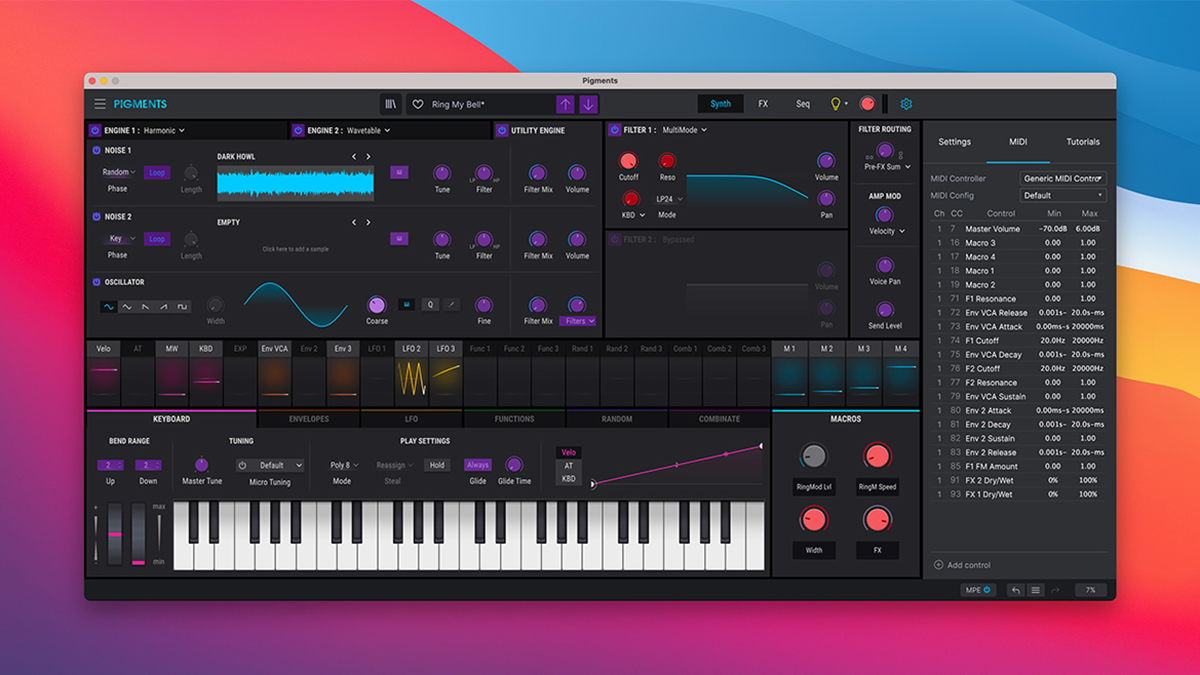MusicRadar Verdict
Pigments 3 enhances an already well-featured instrument. It’s a bargain given the sheer number of features and its sound quality.
Pros
- +
An incredibly powerful modern sounding synthesizer.
- +
Upgrade greatly expands sound design potential.
- +
Includes four new effects.
- +
Runs as a plugin or standalone.
- +
Users can import samples and wavetables.
Cons
- -
Too much to fit in the display.
- -
There’s almost too much factory content!
MusicRadar's got your back
What is it?
After 20 years of successfully producing software synths based on classic hardware products, Arturia released its first unique synth, Pigments, in 2018 - and now we have Pigments 3.
Pigments (Mac/PC) is a synth instrument that works as a standalone application so you can play live with a keyboard controller, or as a plugin within your favourite host software. Pigments combines virtual analogue and wavetable synthesis and includes filters, effects, modulation, sequencing and arpeggiation.
Version 2, released in 2019, added sample-based and granular synthesis, as well as MPE (MIDI Polyphonic Expression).
Now we’re looking at Pigments 3, which includes a new harmonic sound engine for additive synthesis; a utility engine, with a sub-oscillator; supplemental analogue waveforms; and two noise sources - so now up to three engines can be layered together. There are also 80+ new wavetables, and other additions and improvements.
Pigments 3 installs as Audio Unit, VST, or AAX plugins, and also offers a standalone mode. Our review was conducted with a 2019 iMac running macOS Big Sur, Ableton Live 11, and assorted MIDI keyboards and controllers.
All of Pigments’ controls are contained in one panel, but some tab-clicking is required - inconvenient but not unusual for such a full-featured synth. From left to right, there are the preset browser, Synth, FX, and Seq tabs, a tips icon, and master volume.
Below that there are the tabs for three engines - 1, 2, and Utility - followed by a filter section, then a row of modulation controls, with more tabs, this time toggling views of an on-screen keyboard, envelopes, LFOs, functions (three complex modulation sources), randomisation, and combinators (another type of modulation source that combines two other modulation sources).
Finally, at the lower right are four macro controls, and a button that enables MPE and displays some relevant options.
The extensive preset library tells you everything you need to know about Pigments in general - excellent quality sounds, with depth and movement, more focused on blatantly being a synth rather than emulating real instruments, and many using the built-in arpeggiator and sequencer, which are always good with Arturia.
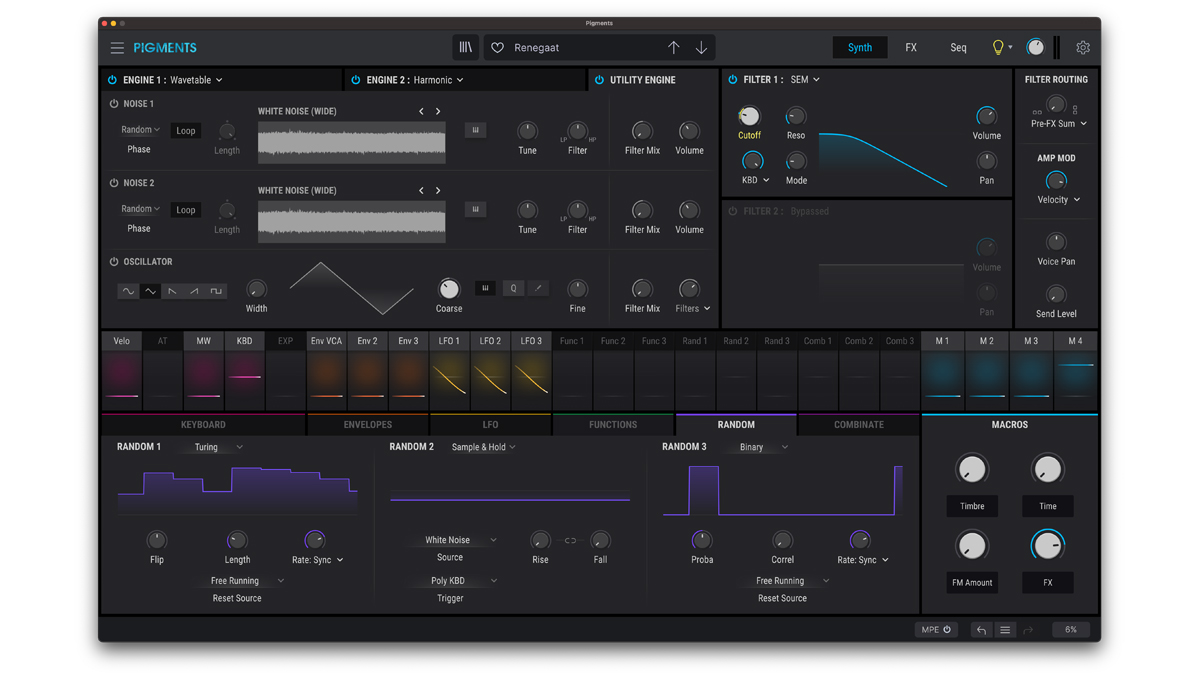
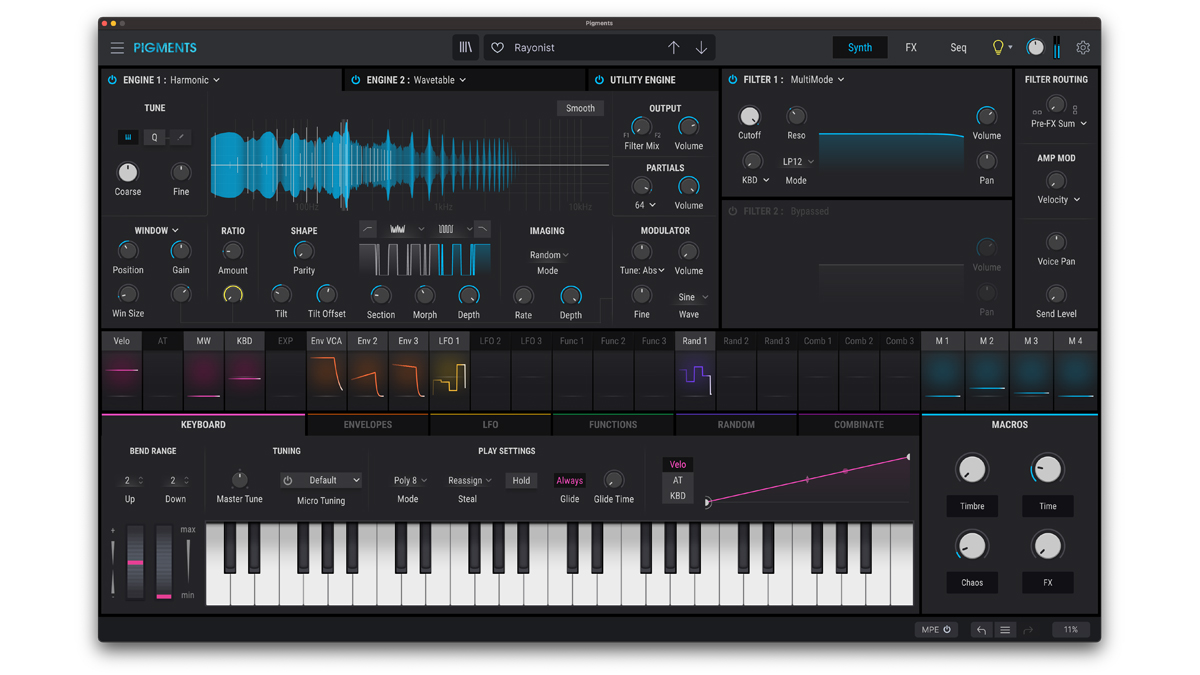
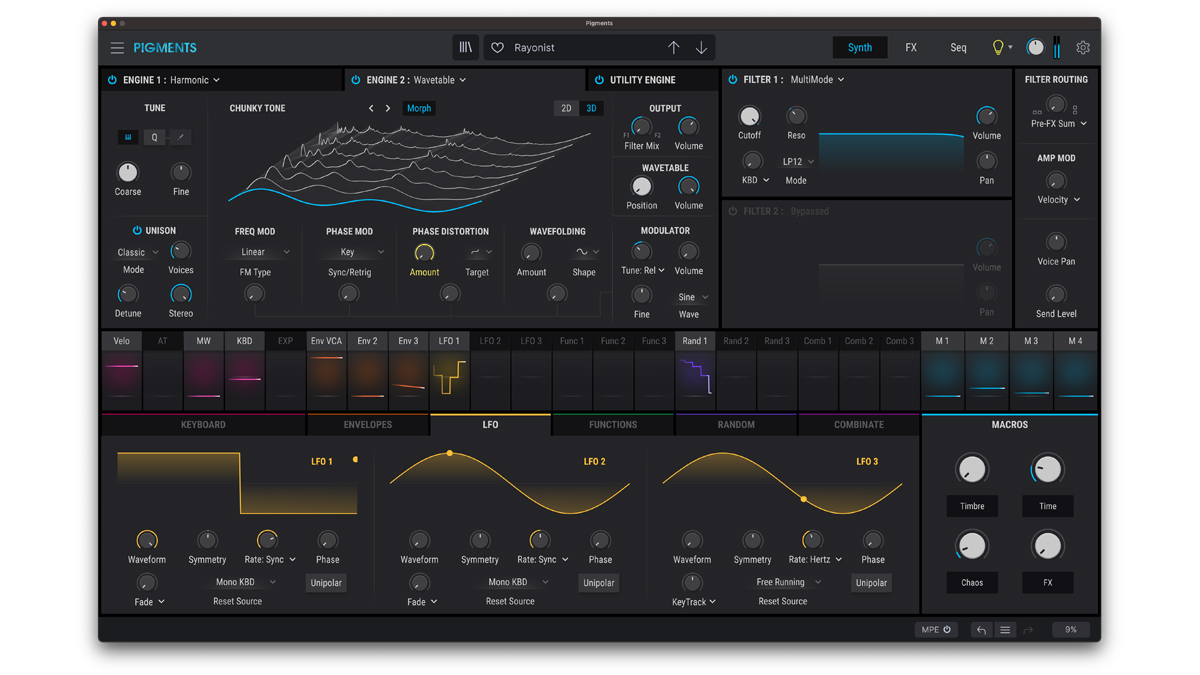
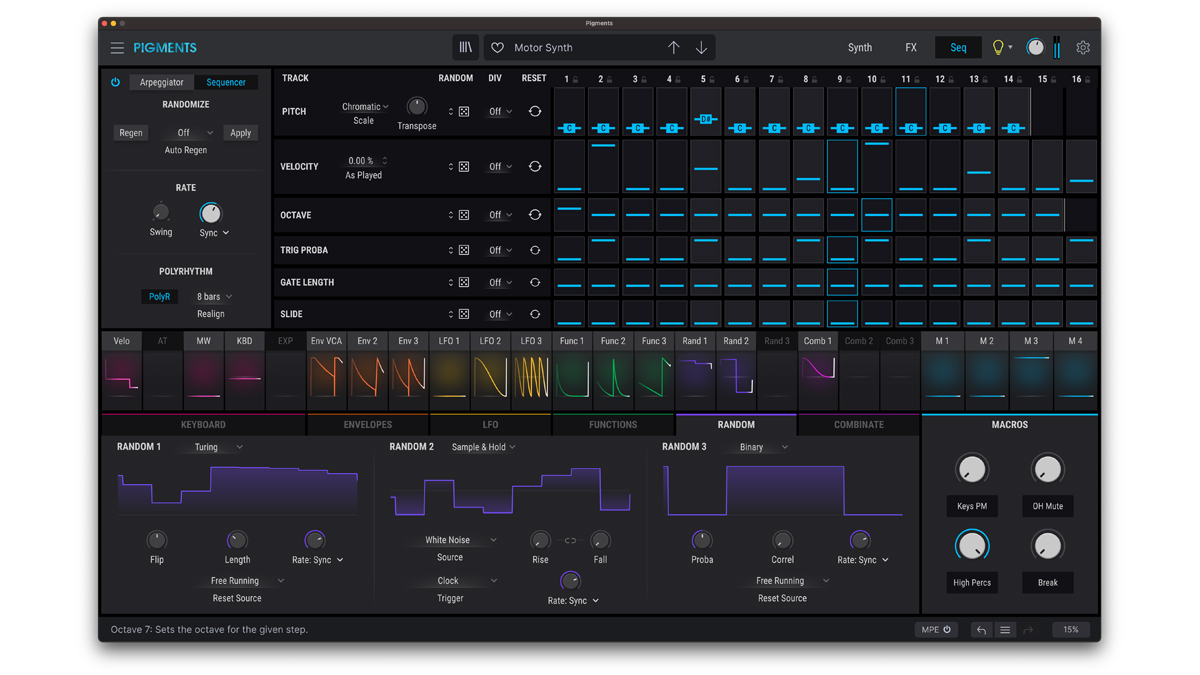
Performance and verdict
As we’ve reviewed Pigments before, let’s focus on what’s new in version 3, starting with the Utility Engine, which is a third sound engine in its own right.
You can even turn off the first two, and use Utility on its own, dialling up two different noise forms, and adding the oscillator and filters.
The noises are based on a range of samples including machine noises, digital tones, and natural sounds such as forests and rain.
The oscillator presents a choice of waveforms, and each element - noises and oscillator - has its own filter mix and volume controls (two filters are shared by all engines).
Being able to stack up three of these engines leads to some profound sound design moments, the third engine enhancing what’s already an excellent sounding synth.
In the same way, a third combinator takes modulation into wild new areas. As we said earlier, these give you a way of building a modulation source from others, with assignable behaviours for each, so you might take LFO 1 and LFO 2 as sources, then choose how they’ll combine (difference, multiplication, and so on). Each combinator can also use the other two combinators as a modulation source.
Four new audio effects have been added, in the form of a rather excellent pitch shift delay, a multiband compressor, the BL-20 flanger, and Jun-6 Chorus derived from Arturia’s V Collection.
Pigments isn’t a token gesture - it’s a fully functioning, potentially deep, synth in its own right.
We didn’t have an MPE compatible controller available for this review, and it’s not a new addition to Pigments 3, but we just want to mention that we used Live 11’s new MPE envelopes features to control Pigments, and it worked very well with some of Sensel’s free Pigments presets.
Pigments 3 is up against many other big-name synths, but really it’s not a competition, as they all have their good points. A list of the usual names could include Serum, Massive X, Iris 2, Hive 2, and Sylenth1. And let’s not forget that most DAW software includes a great synth or two, examples being Ableton Live’s Operator, Bitwig Studio’s Phase-4, and Logic Pro’s Alchemy.
The truth is we all end up with more synths than we know what to do with! Pigments has always stood apart from Arturia’s more ‘traditional’ collection of vintage synth virtual instruments, though, and we mean that in the best possible way.
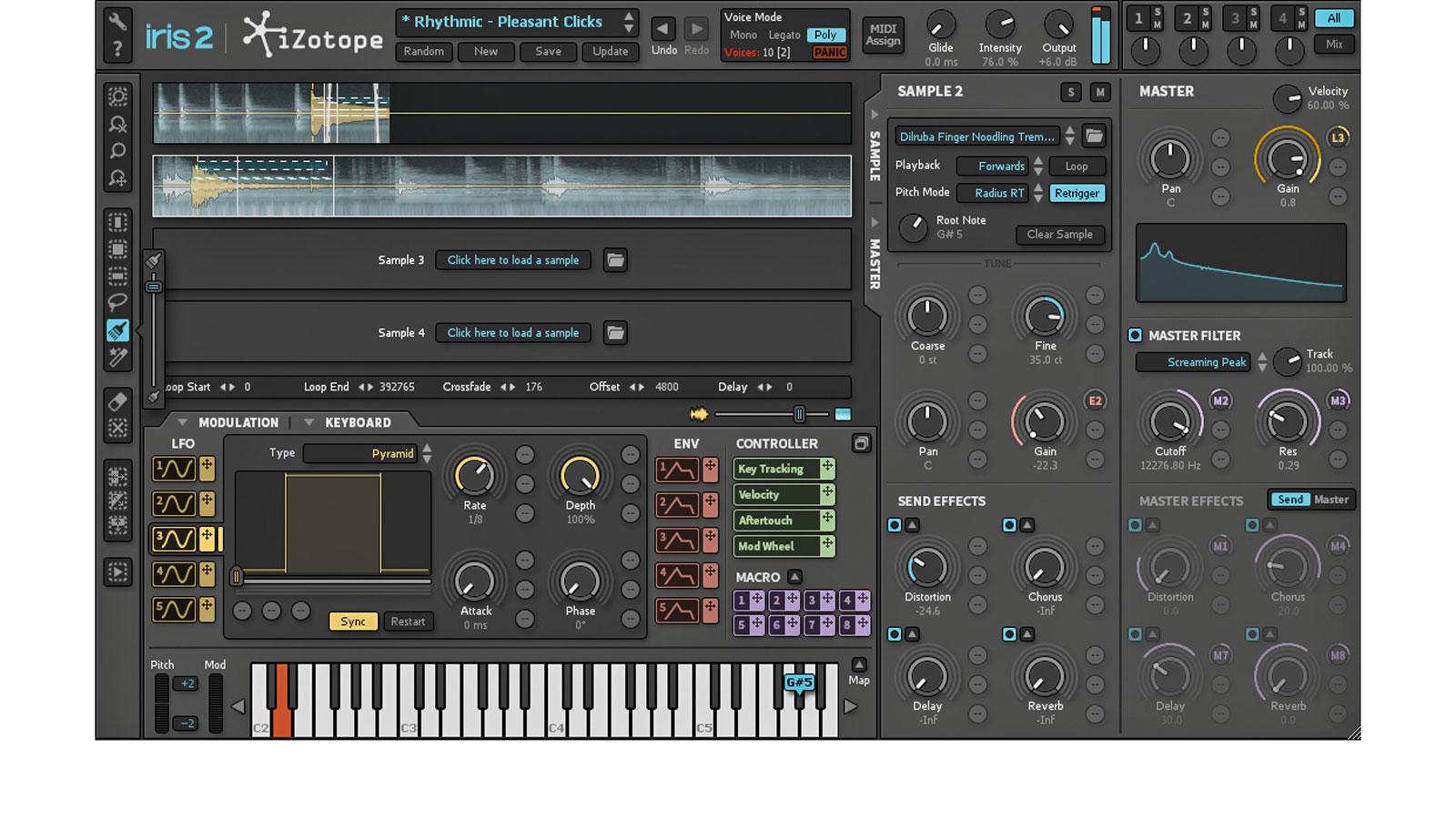
• iZotope Iris 2
Iris 2 is primarily about sample-based synthesis, but also includes oscillator-generated synthesiser waveforms and, of course, audio effects.
• Xfer Records Serum
Ever-popular Serum is a wavetable synthesiser that includes sample loading and editing within the synth without requiring external tools.
This isn’t a situation where you choose one style or another, and for Arturia, we’d guess it’s a way of keeping users connected to them even when they want different, more modern, sounds - especially as bundle prices and discounts for current users are available.
And why on earth not? Pigments isn’t a token gesture - it’s a fully functioning, potentially deep, synth in its own right.
There’s no need to debate the value of upgrading, as it’s free for anybody who’s using Pigments 1 or 2 already. For those who aren’t using Pigments already, this could be a good time to jump on board; this is a great sounding synth that can go very complex in function while still being easy to use, with some fantastic presets, and the control layout is impressively clear and rewards experimentation.
Sometimes we wish we could see more of the content contained in the various tabs at once, but that’s about it as far as criticisms go. Used as a plugin or standalone, Pigments 3 is a fine addition to any synth library.
MusicRadar verdict: Pigments 3 enhances an already well-featured instrument. It’s a bargain given the sheer number of features and its sound quality.
Hands-on demos
Specifications
- TYPE: Virtual analogue and wavetable softsynth
- KEY FEATURES: New Harmonic and 3rd Utility engines.
64 new wavetables, bringing the total to 164.
Ramp waveform, for Virtual Analog engine.
Enhanced filter routing with new Jup-8 V4 Low-pass filter.
New Pitch Delay, Multi-Band Compressor, BL-20 Flanger and Chorus JUN-6 effects. - SYSTEM REQUIREMENTS: Standalone, VST, AAX, Audio Unit.
Windows 8.1+ (64bit) PC: 4 GB RAM; 2.5 GHz CPU. macOS 10.13+: 4 GB RAM; 2.5 GHz CPU. 2GB free hard disk space.
OpenGL 2.0 compatible GPU. - CONTACT: Arturia
Computer Music magazine is the world’s best selling publication dedicated solely to making great music with your Mac or PC computer. Each issue it brings its lucky readers the best in cutting-edge tutorials, need-to-know, expert software reviews and even all the tools you actually need to make great music today, courtesy of our legendary CM Plugin Suite.
“Every note counts and fits perfectly”: Kirk Hammett names his best Metallica solo – and no, it’s not One or Master Of Puppets
Ranked: Bon Iver's albums, from Sable, Fable to For Emma, Forever Ago
“Its mission is simple: unleash the power of any amplifier or line-level source without compromise”: Two Notes promises a “watershed” in tube amp control with the Torpedo Reload II
